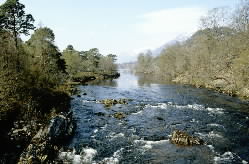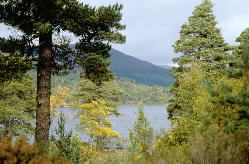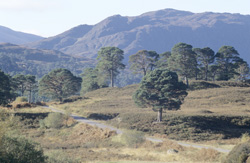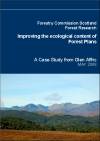Summary
 A Case Study from Glen Affric
A Case Study from Glen Affric
Summary
Glen Affric forms part of the Upper Beauly Catchment Forest Design Plan (FDP) area and contains the largest area of Caledonian forest owned by the Forestry Commission as well as a range of other habitats of conservation importance.
The challenge of this project was to convey a long-term vision of the desired forest structure and habitat dynamics for the next 150 to 200 years as the forest is managed less intensively and reverts to more natural dynamics.

This vision would be supported by an evaluation of options and the creation of a plan that best meets objectives for the next 20 to 30 years.
Finally, a specific approved programme of work for the next 10 years would be prepared to build into business planning and funding strategies.

Research objectives
- To look at how the ecological content of Forest Plans for important biodiversity sites could be improved
- To assess to what extent our information tools, analytical models and advice could help to achieve this and how these might be integrated into the Forest Plan process
- To assess what happens when models are used in combination
- To develop a process to help Forest District teams to deal with large amounts of data and a large, complex area
- To allow us to understand how managers might use the models and advice.
The current Forest Plan
Area covered
The current forest plan covers 17,245 Ha in the heart of the north central Highlands and encompasses Glen Cannich to the north, the western part of Strathglass, Cougie and Guisachan to the south and Glen Affric at the centre. It extends some 18 miles from the Village of Cannich in the northeast to Alltbeithe in the southwest.
It thus covers a range of climatic conditions with rainfall varying from 1600 mm in the east to 2800 mm in the west as well as an altitudinal range from 100 m above sea level in the east to over 1000 m in the west.
Context
A range of GIS supported tools have already been used to improve the ecological content and function of the current FDP, which is in a predominately native woodland setting:
- Biological and Environmental Evaluation Tools for Landscape Ecology (BEETLE) which provides a landscape scale approach to habitat management
- Ecological Site Classification Decision Support System (ESC-DSS) to help guide forest managers and planners to select species ecologically suited to sites
- ForestGALES computer based decision support tool which enables forest managers to estimate the probability of wind damage.
It was agreed that there was a need for better incorporation of these modelling approaches into the design planning process within the Upper Beauly Catchment. The use of these models can help with the spatial delivery of the management objectives but also improve the objectivity, transparency and accountability of the decision-making process in relation to habitat factors at the landscape scale. The work in Glen Affric could also act as an exemplar for other FDPs.
Currently, predictive modelling is limited by the availability of good data on forest structure and composition. The Forest Enterprise Sub-Compartment Database (SCDB) holds valuable information on planted stands, but semi-natural woodland needs to be characterised in a way that is meaningful in terms of habitat requirements for key species, but is relevant also to the types of data that can be held within the database (Watts et al., 2005).
Results – comparison with the current Forest Plan
The process undertaken did not suggest radical changes of direction to the overall concept or vision. However, it provided a clearer rationale for decisions and an alternative, ecologically based prioritisation for management programmes. It added detail and give a spatial dimension to some of the more general aims of the plan and producing a more robust and justifiable outcome. It also helped to fill some of the gaps in the baseline survey.
The application of ecological principles places priority on consolidation and improving the habitat quality through restoration and improving connectivity before expansion of woodland area. The incorporation of habitat network theory into the forest plan process provides a framework for consideration at a range of different geographical scales, e.g., the landscape scale including the consolidation of downstream networks for the whole of Strathglass from Beauly to Tomich and as well as at a more local area, e.g., Cougie.
 Improving the ecological content of Forest Plans (PDF-3614K)
Improving the ecological content of Forest Plans (PDF-3614K)
May 2008.
Funders and partners
![]()
The project was a partnership between Fort Augustus Forest District, Forest Research and Forest Enterprise Scotland Management Board (FESMB – environment, planning and landscape architect managers), with input from other bodies such as Scottish Natural Heritage (SNH) and Trees for Life.
Forestry Commission policy
The national and international importance of its landscapes and the range of habitats and species that the area supports is recognised and protected by a number of overlapping designations, each with features requiring protection under EU or UK law. These are reflected in the requirements of the UK Forestry Standard and UK Woodland Assurance Scheme (UKWAS). Designations can apply to the site, the habitats found on that site or species which use those habitats.
Status
Ongoing, so that lessons learned from this project are incorporated into the new FDP.
There was interest in pursuing:
- Continued input of ecological knowledge when the real forest plan for the area is undertaken
- Continued method development – how best to integrate multiple objectives
- Increased availability of ecological knowledge, either by producing operational versions of the models, or considering some form of regionally-based model expertise, or Forest Research service
- A test of the process in another case study area where ecological issues were not predominant (as in Glen Affric), but were part of the mix of objectives (e.g. a more typical upland forest).
Reference
Watts, K., Humphrey, J.W., Griffiths, M., Quine, C.P. and Ray, D. (2005). Evaluating biodiversity in fragmented forest landscapes: principles (PDF-488K). Forestry Commission Information Note 73. Forestry Commission, Edinburgh.
